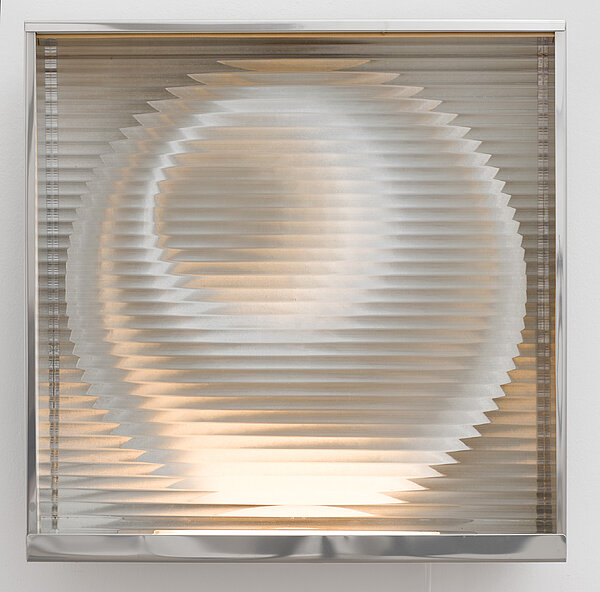Heinz Mack
Silber-Mond-Rotor, 1971
[Silver Moon Rotor]
Rippled glass, stainless steel, aluminium,
fluorescent tube, motor, wood
50,5 x 50,5 x 16 cm
© VG Bild-Kunst, Bonn 2022
Photo: Gerhard Sauer
In 1959, Heinz Mack began making motorised objects based on materials that were commonly used in the growing post-war aerospace industry. His rotors, made chiefly of aluminium and ribbed glass, opened up perceptual possibilities of the kind aspired to by the ZERO group that Mack co-founded with Otto Piene. The concern behind the objects they constructed was with space, light, and motion – and with the visual dissolution of matter into light and movement. Light reflected and refracted by the relief-structured surfaces of the rotors generated the impression of vibration and called for an active beholder. According to the ideas of ZERO, not only should the artistic subject, emotion, and spontaneity be conveyed through a work: the recipient observer was now also to be placed at the heart of the concept. With this stance, Heinz Mack, Otto Piene, and Günter Uecker, who joined them slightly later, assumed a counter-position to the subjectivistic currents of l'art Informel. In their writings they emphasised the physiological aspect of perception in art, drawing on older European art theories, such as in the texts of László Moholy-Nagy. Despite this reception, the art produced by ZERO – at first still oriented to panel painting formats, and then focusing on kinetic and installational approaches – was trail-blazing. Already the name of the group, borrowed from the countdown for a rocket launch, stood for a new start, an optimistic outlook, and the building of a better world.
Not only the involvement of the viewer, but also a new formal aspect became characteristic of Heinz Mack’s art: a reduction in chromaticity and structure. This is particularly apparent in his lumino-kinetic works, such as Silber-Mond-Rotor [Silver Moon Rotor] from 1971. Set behind a pane of horizontally ribbed glass is a circular, motor-driven plate of silvery aluminium. The box is lit on the inside by a fluorescent tube, so that the reflective properties of the metal are brought into effect – to which the incoming ambient light sets up an additional lively play on the disc’s structured surface. Through the combination of light and motion, the contours and structures of the materials visually dissolve – creating the illusion of spatio-dynamic forms that are reminiscent of floating heavenly bodies. (Jutta Fischer)
Heinz Mack
1931 born in Lollar (DE)
Lives and works in Mönchengladbach (DE) and on Ibiza


